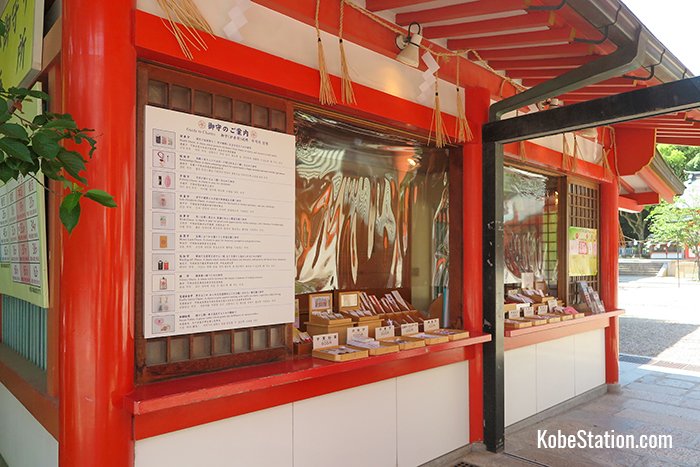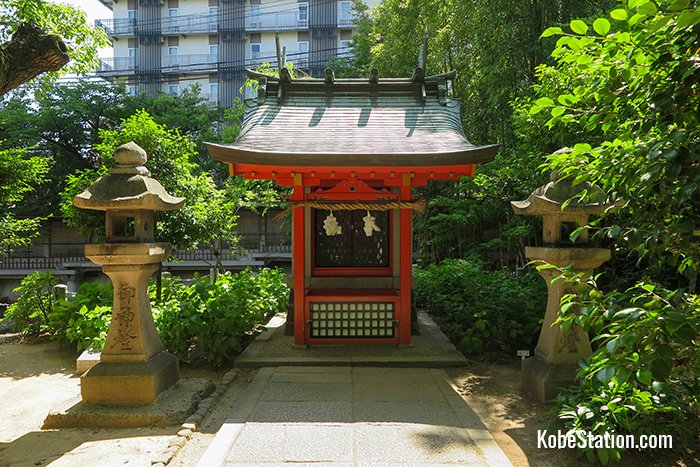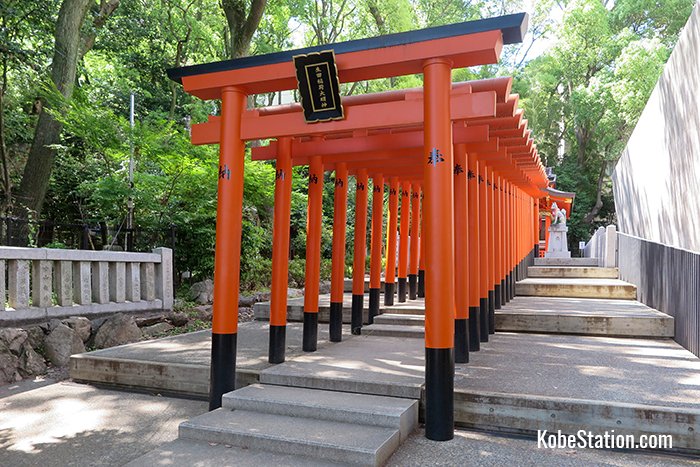Ikuta Jinja is a major shrine in Kobe and is believed to be one of the oldest shrines in Japan. Located a short walk from JR Sannomiya Station, this shrine in Kobe’s city center has spacious grounds, impressive buildings and at its rear you can find a remnant of the ancient forest that once covered the entire area.

The entrance to Ikuta Jinja is a short walk from the Sannomiya stations
The main shrine is dedicated to the goddess Wakahirume. Because she is the goddess of weaving she is said to be good at making connections — whether these be business connections or romantic connections — so people pray to her for prosperity in business and happy marriages.

The second torii gate on the approach to the main shrine building
Also, because the shrine has survived many disasters in the past, people also pray here for their health and for protection from calamity.

The tower gate on the approach to the main shrine building
History
According to the Nihongi, a chronicle of Japan’s earliest history, Ikuta Jinja was founded in 201 by the Empress Jingu. According to this account, the Empress Jingu was returning from war on the Korean Peninsula when her ship was forced to stop by bad weather at what is now Kobe harbor. There she held a divination ceremony that summoned the goddess Wakahirume, and the goddess said she wanted a shrine to be built for her in a place called Ikuta.

The shaden or main shrine building where Wakahirume is enshrined today
Originally, the shrine was located further north from its current location on Mount Isagoyama. However, in 799, terrible floods threatened to wash the shrine away. A priest then carried the goddess in a portable shrine in search of a new home. After 8 days the portable shrine suddenly became too heavy, and taking this as a divine message, the goddess was re-enshrined at its present location.
In 806, 44 households were given responsibility for the care and protection of the shrine and given the title “kanbe” (which means “sacred households”). This was the origin of the name of the city of “Kobe”, which is written with the same characters.

Inside the shaden
In recent history, the shrine has suffered damage during floods in 1938, firebombing in 1945, and the Great Hanshin Earthquake in 1995. However, following each tragic event the shrine was restored with the support of local citizens. As a result, Ikuta Jinja is now loved and respected by the people of Kobe as a symbol of the city’s resilience.
Inside the Shrine Grounds
Before passing through the tower gate you will see a roofed basin on your right. This is called a chozuya and it is where visitors ritually purify themselves before approaching the main shrine building or shaden.

The chozuya basin
To purify yourself, take a bamboo scoop and wash your hands and mouth with the water.

A booth in the tower gate
As you pass through the tower gate you will see booths on either side where you can buy a variety of protective charms which are called omamori.

A variety of omamori charms
To the left of the shaden is a pond called Ikuta-no-ike.

Ikuta-no-ike
In the pond there is a little island which can be reached by a bridge and on the island is a small sub-shrine called Ichikishima Jinja. This shrine is dedicated to Ichikishima-hime, also called Benzaiten, who is the goddess of water and all things that flow — like language and music.

Ichikishima Jinja
This is just one of 14 sub-shrines dotted around the grounds of Ikuta Jinja, which are each dedicated to a different god.

Daikai Jinja
Close to the entrance of Ikuta Jinja are two sub-shrines that are quite important. On the left side just after the second torii gate is Daikai Jinja (literally “Ocean Shrine”), which is dedicated to Sarutahiko, a god of guidance and travel. People pray here for safety at sea — which is very important in a port city like Kobe.

Matsuo Jinja
On the right side after the second torii gate is Matsuo Jinja, which is dedicated to Oyamakui, the god of farming and sake brewing. Kobe is the home of many famous sake breweries so this is an important shrine for them.

Inside Ikuta-no-mori
At the far end of Ikuta Jinja’s grounds behind the shaden are the remains of an ancient forest called Ikuta-no-mori.

Looking up at the tree-tops in Ikuta-no-mori
Although this is a quiet and peaceful spot today, in the 12th century the forest was the site of a major battle during a period of civil strife known as the Genpei War.

One of the ancient trees in Ikuta-no-mori
Inside the forest is a sub-shrine called Ikutamorizasha, which is dedicated to the Empress Jingu. People pray here for growing things and for the safe birth of babies.

Ikutamorizasha
Also in the forest are the remains of a sacred camphor tree. From its rings it can be seen that this tree was around 500 years old when it fell. It is considered sacred because it survived the bombing of Kobe during World War II and although terribly burned, it recovered and continued to live for many years. Because of this the tree is seen as a symbol of reconstruction and revival.

The sacred camphor tree
You can also find an Inari Shrine dedicated to the god of rice in Ikuta-no-mori.

The many torii gates that lead to the Inari Shrine
Rice, as the traditional staple food of Japan, is very important to the Japanese people, so Inari is a very important god, who is also considered the god of fertility and life.
Location
Ikuta Jinja is a seven-minute walk northwest of JR Sannomiya Station. Here is a map showing its location.
Article and original photos by Michael Lambe. All rights reserved.
